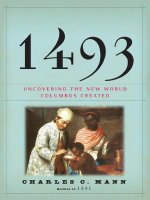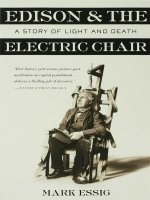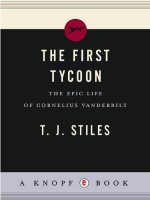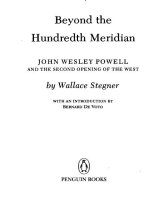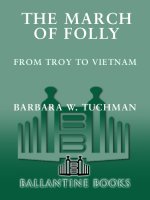Daniel meyerson in the valley of the kings ho omb (v5 0)
Bạn đang xem bản rút gọn của tài liệu. Xem và tải ngay bản đầy đủ của tài liệu tại đây (1.36 MB, 159 trang )
ALSO BY DANIEL MEYERSON
The Linguist and the Emperor: Napoleon and
Champollion’s Quest to Decipher the Rosetta Stone
Blood and Splendor: The Lives of Five Tyrants, from
Nero to Saddam Hussein
For
PHILLIPE, (AL)CHEMIST EXTRAORDINAIRE
and
MUSTAFA KAMIL
I HAVE SEEN YESTERDAY. I KNOW TOMORROW.
—INSCRIPTION IN THE TOMB OF
PHARAOH TUTANKHAMUN, 1338 BC
CONTENTS
A Note on the Map of Egypt
Map of Egypt
Tutankhamun’s Family Tree
PART ONE
EXPENSES PAID AND NOTHING ELSE (BUT FATE)
PART TWO
NAKED UNDER AN UMBRELLA
PART THREE
THE WORLD OF NEBKHEPERURE HEKAIUNUSHEMA TUTANKHAMUN
PART FOUR
IN THE VALLEY OF THE KINGS
PART FIVE
A USEFUL MAN
PART SIX
A FINAL THROW OF THE DICE
Epilogue
Acknowledgments
Notes
Selected Bibliography
A NOTE ON THE MAP OF EGYPT
There are two sources for the Nile—one is in Uganda, the other in the Ethiopian highlands. The “two” Niles, the
Blue Nile and the White Nile, join in the Sudan, at Khartoum, and begin their long journey toward the
Mediterranean. When the Nile reaches Cairo, it fans out into many branches that run through a low-lying delta
region to the sea. The area around Cairo and the delta is known as Lower Egypt.
Somewhat south of Cairo (120 km south, to be exact, about a subject that is not exact), we arrive at the city of
Beni Suef, which is a good conventional demarcation point between Lower Egypt and Middle Egypt. Middle Egypt
may be said to run to a city on the Nile called Qus, which is 20 km north of Luxor. Upper Egypt starts here and
runs south, encompassing Nubia, an area that includes northern Sudan (part of Egypt in ancient times).
Ancient Egyptians thought of their country as having two parts: Upper and Lower Egypt. Their history was
said to have begun with the uni cation of the Two Lands (one of the names for Egypt) when the king of Upper
Egypt conquered the north. This duality was re ected in countless ways in Egyptian iconography, most
prominently seen in the pharaoh’s Double Crown. The basketlike Red Crown, symbol of the north, would be worn
inside the cone-shaped White Crown of the south.
Over time, the north/south duality became part of the multifaceted dialectic that obsessed Egyptian thought:
North/south, barren desert/fertile farmland, birth/death were not merely facts of life, but inspired art, ritual, and
myth for this imaginative, speculative people.
PREVIOUS PAGE: Howard Carter seated beside the coffin of
King Tutankhamun, removing the consecration oils that covered the
third, or innermost, coffin, 1926. © GRIFFITH INSTITUTE,
UNIVERSITY OF OXFORD
E
New Year’s Day 1901
Deir el-Bahri, Southern Egypt
excited crowd had gathered beneath the
stark cli s that rose dramatically behind the two ancient temples. One was dedicated
to the soul of Queen Hatshepsut, 1550 BC, and the even older one next to it, Mentuhotep
I’s, had stood there in the relentless sun for four thousand years.
It was a place of great desolation and silence. Behind the temples towered the lifeless
cli s; and before them, the blinding white sand stretched endlessly to meet the empty
sky . Djeser djeseru, the ancients called it, the holy of holies, the dwelling place of
Meretsinger, the cobra goddess: She Who Loves Silence.
And it was here that the noisy crowd descended, chattering, speculating, lled with the
nervous restlessness of modernity. In search of sensation, treasure, beauty—how could
the goddess bear them as she watched from her barren heights?
First and foremost was the British viceroy, Lord Cromer, a man whose word was law
in Egypt. He’d dropped everything, leaving Cairo in the midst of one of Egypt’s endless
crises. After ordering his private train, he’d traveled ve hundred miles south, then
taken a boat across the Nile, and then a horse-drawn calèche out toward the desert
valley. The price of Egyptian cotton had plummeted on the world market, pests were
ravaging the crops, and starvation stalked the countryside. But what did that matter
next to the fact that a royal tomb had been discovered? After months of laborious
excavation, the diggers had nally reached the door of a burial chamber with its clay
seals still intact—and His Lordship wanted to be present at the opening.
As did an assortment of idle princes, pashas, and high-living ri ra from the
international moneyed scene … along with the usual hangers-on of the very rich:
practitioners of the world’s oldest profession. Which in Egypt didn’t refer to—to what it
usually does, but meant grave robbers (or archaeologists, as they are more politely
known).
To dig with any success (“to excavate,” in the polite lingo), one needed knowledge.
And one needed money—a great deal of it.
Thus, they often came in pairs, the archaeologists and their sugar daddies. There were
famous “couples”—inseparables for all their di erences of temperament and
background. For example, looking back on turn-of-the-century Egyptology, can one
think of the American millionaire Theodore Davis apart from the young Cambridge
scholar Edward Ayrton?
Together they discovered a long list of tombs and burial shafts, Pharaoh Horemheb’s,
Pharaoh Siptah’s, and “the golden tomb” (KV #56)1* among them. As well as the
mysterious Tomb Kings Valley #55—and the animal tombs (#50, #51, and #52): the
mummi ed and bejeweled pets of Amenhotep II. The beloved creatures had been
VERYONE WHO WAS ANYONE WAS IN THE DESERT THAT DAY. AN
stripped of their jewelry by ancient robbers who had even decided to create a “joke”—
perhaps the oldest in existence—leaving pharaoh’s monkey and dog face-to-face. Which
was how Davis and Ayrton found them some three thousand years later: locked in an
eternal stand-off.
The two men, the millionaire and the scholar, made a striking picture: Davis,
headstrong, determined, unwilling to be denied anything he wanted. The entrepreneur
stood erect, staring down the camera in his ared riding pants and polished boots and
gray side whiskers; Ayrton stood next to him, athletic, boyish, shy, a straw boater tilted
at a rakish angle as he smiled absentmindedly staring out over the desert. If it wasn’t
exactly a marriage made in heaven—the two had their ups and downs—still their
partnership produced significant results.
Or take Howard Carter and Lord Carnarvon, another such couple. Carter, irascible to
the point of being rabid when the t was on him, intense, brooding, obsessed. With
almost no formal education and a humble background, he was the quintessential
outsider whose artistic ability was his one saving grace. Where would he have been
without his Earl of Carnarvon, the lovable “Porchy”—bon vivant heir to a thirty-sixthousand-acre estate who came to the excavations supplied with ne china, table linen,
and the best wines?
Though they tried to pass themselves o as patrons of the arts and archaeology, the
truth was that these high rollers were not sel ess. They paid for an excavation because
they stood to gain a great deal from it, more than they would have at the racetracks and
roulette tables of their usual watering holes.
The laws—or, better, the rules of the game—in Egypt allowed for an equal division of
whatever was found: statues, jewelry, papyri. The edgling Egyptian Museum at Cairo
got half the take, the other half went to the wealthy diggers. It was this prospect that
drew the British earls and American millionaires to the remote desert wadis with their
magnificent treasures … and their ancient curses and gods.
There was, however, one exception in this high-stakes game, the wild card in the deck:
an intact royal burial. A pharaoh’s tomb or a queen’s sepulcher undisturbed since the
time of its sealing. In the case of such a discovery, all bets were o and the rules
changed. In theory, everything went to the Egyptian Museum—though what would
happen in practice no one knew, since up to that time such a discovery had never been
made. What was more, it was such a remote possibility that those in the know
discounted it. The tombs found so far had all been at least partially plundered in
antiquity.
But this discouraged no one, since a plundered tomb could be astonishing enough.
What had been worthless to the ancient thieves was often worth a fortune to their
modern counterparts. The early grave robbers concentrated on gold and silver, or on
jars lled with costly perfumes and unguents. They would pour the oils into animal
skins to be easily carried away, leaving behind exquisite works of art. They couldn’t
have fenced the nely carved statues. Or the limestone and alabaster sarcophagi, the
painted co ns and splendidly illustrated rolls of papyri. Such priceless leavings made
the game well worthwhile (a game that in modern terms came to hundreds of thousands
of British pounds, or American dollars, or French francs).
Then, too, there were the accidental nds stumbled upon in such “plundered” tombs:
amulets overlooked in the folds of mummy wrappings or jewelry dropped in the haste of
an ancient getaway. A “worthless” crocodile mummy, brittle to the touch, would crack
open to reveal a hundred-foot papyrus roll, a masterpiece of the calligrapher’s art. A
mummi ed arm would be discovered—the arm of Queen Mernneith, broken from her
body and thrust into a niche during the First Dynasty (3000 BC). Laden with wondrously
worked golden bracelets, the arm had been plastered over by some hapless thief who’d
never managed to return for his booty. His loss was his modern “brother’s” gain (the
severe and Spartan W. Flinders Petrie, working over the supposedly exhausted Abydos
site with a fine-tooth comb).
With so much at stake, is it any wonder that Egypt was a place of feverish rumors and
speculation? Competition was erce: among private collectors, among dealers in
antiquities (both real ones and forgeries), and among the great museums of the world.
The Louvre, the British Museum, and the Metropolitan Museum of Art all had their
unscrupulous representatives at work. Greedy, squabbling children, they were anxious to
obtain the nest examples of ancient art: provenance known or unknown—no questions
asked.
Of course, they were all there in the desert on that hot, bright November day. The
opening of an intact royal tomb was not an event they were likely to miss. Nor would
the “father” of this naughty family overlook such an occasion: Gaston Maspero, the
mudir, or director, of the Service des Antiquités, a devoted scholar whose job it was to
keep his acquisitive children in check.
Portly, middle-aged, unworldly—a French academic—Maspero had come to Egypt in
1881 to become the second director of the newly established service. His position as
mudir had forced him quickly to learn the ins and outs of the shady antiquities markets.
His rst task had been a very “unacademic one”: to trace the source of a steady stream
of treasure, recognizably from royal burials, that had been showing up on the market.
With the help of a wealthy American collector (Charles Wilbour) and an agent working
for both Russia and Belgium (Mustafa Aga Ayat), Maspero followed a torturous trail. It
began with two leather strips, outer mummy wrappings, and led to a notorious graverobbing family, the Abd er Rassuls.
Maspero had its members “interrogated” roughly. For though he was soft-spoken and
humane, when it came to saving antiquities he could be as hard as nails. He ordered a
bastinado for the culprits, a beating on the soles of their feet. Ironically, it was a harsher
method than the one used on the ancient grave robbers, who were merely lashed on the
back to make them talk (the blows given by the hundred, one wound counting as ve
blows). The bastinado, though, besides causing the whole body to swell, created extreme
mental anguish. It left Ahmad er Rassul, the brother who nally confessed, crippled for
life (afterward, Maspero was clever enough to recruit him as a service inspector).
The disclosures led to the discovery of a remote desert tomb known as the Deir el-Bahri
cache—the hiding place of thirty royal mummies, among them Amenhotep I; Thutmosis
I, II, and III; Seti I; Ramesses II and III; and the royal family of the priest-pharaoh
Pinedjem. During the breakdown of order in Egypt (in the Twentieth and Twenty- rst
dynasties), the royal mummies had been taken from their tombs by priests striving to
protect their sacred god-kings. Moved from place to place, they were nally reburied
here, DB tomb #320.
Here they had remained for three thousand years—and might have remained forever if
not for some roaming Arabs. One idly threw a stone into a cleft in the face of the cli s,
and the hollow ringing echo alerted an er Rassul brother who was with them. Keeping
his suspicions to himself, he frightened his companions with talk of demons and ghosts
in the area. Then he and his brothers returned to investigate. As a result, the er Rassuls
had been selling the tomb’s treasures bit by bit for over a decade.
Maspero had the royal mummies taken upriver to Cairo. They made the long trip to
wailing all along the way, “the women screaming and tearing their hair,” as Emile
Brugsch, Maspero’s assistant, wrote. The peasants crowded to the riverbank, lling the
air with a ritual lamentation. Their stylized wailing went back to the earliest epochs of
history, when the pharaoh’s death was an act of cosmic signi cance: It represented the
death of a god, the eclipse of the sun, a time of danger and instability. Perhaps moved
by some obscure instinct, the mourning villagers now reenacted the same scene that had
taken place thousands of years before.
Once in Cairo, the mummies were eventually studied with the most up-to-date
scienti c methods of the time.2* The notes scrawled on their co ns were translated and
the history of their wanderings recorded. Finally put on display, their expressive
features—faces from another world—were gazed upon by an admiring multitude. And
thus Maspero began his directorship of the service with a resounding success.
Maspero’s position plunged him into the thick of Egyptian politics. Among his many
responsibilities was the granting of concessions to excavate. It was up to him to decide
which ancient sites went to whom. National passions were at their height in the years
before World War I, and the claims of British diggers had to be considered against
French ones, not to mention American, Italian, and German rivalries. Complicating
matters was the fact that the British exercised political control over Egypt, while the
French had been culturally preeminent in the country since Napoleon’s invasion a
century before.
By nationality Maspero was French; by extraction he was Italian; and in his
sympathies he was Anglophile. But the cause closest to his heart was knowledge. He
sought to strengthen the service, hoping in this way to preserve the ancient sites and to
stop the unrestrained looting of Egypt’s treasures.
A beautifully wrought work of art had a monetary value on the antiquities market. But
when exact information as to where it had been found could be obtained—when it could
be put into a historical context—its scientific value increased tenfold.
Both realist and idealist, Maspero knew that money was the key. Money not only to
excavate, but also to preserve what had already been uncovered. To guard the temples
and tombs, to restore them, to record the inscriptions covering their walls. Since scant
public funds were available, private contributions were a necessity—and such
contributions often had to come from the very people he had to be most wary of.
In pursuit of his goals, the new director cultivated a wide range of friendships, anyone
and everyone who could be of help. There were the poor itinerant scholars: men and
women wandering among the ruins, notebooks in hand, their families moving from
pension to pension ( gures such as James Breasted, whose translations of ancient
inscriptions in Egypt and Nubia ran into many volumes and remain a standard work;
his son Charles recalls meager meals in backstreet Egyptian restaurants, his parents
dividing the food among the three of them with a careful hand).
And there were the wealthy itinerant aristocrats—an international crowd wintering in
Egypt. They sailed the Nile on luxurious dahabiyyas or were pampered in fantastically
opulent hotels such as Shepherd’s in Cairo or Luxor’s Winter Palace. Maspero was
always a welcome presence among them: earnest but never gauche; witty and sociable.
He enlisted the help of pious churchmen, reverends eager to prove the historical truth
of the Bible; and he employed impious thieves of every stripe and rank, high and low.
An embassy clerk might pass on a tip as to what was being smuggled out in the
diplomatic pouch: a rare scarab, a pharaonic diadem, or a bust such as the famous one
of Nefertiti that was brought to Berlin in this way.
It is a wonder that Maspero, understa ed and overworked, had the energy not only to
ful ll his duties as mudir so brilliantly, but at the same time to pursue his scholarship.
But somehow he did—keeping one eye on the fashionable guest list of Shepherd’s Hotel
and the other on a papyrus scroll. His knowledge of the monuments was encyclopedic,
his writings were proli c, and his work on the pyramid texts was groundbreaking. He
was rst among the Egyptologists of his generation, at the same time taking under his
wing many young hopefuls of the next.
Among those Maspero encouraged was Howard Carter, though the young man t into
none of the usual categories. He had no education, no money, no family background,
and no training in Egyptology. He could speak neither Arabic nor French, and his
manners were awkward and abrupt. He was taciturn, brooding, and bad-tempered. He
didn’t even have the robust constitution required for turn-of-the-century archaeology,
when diggers lived for months on tinned food, sleeping in tents or ancient tombs cut
into the cli s. He had nothing but his stubbornness, an iron determination to make
good.
His roots were rural and lower class. His grandfather had been gamekeeper on a
Norfolk country estate, where his family had lived for generations. Carter’s father,
Samuel, had been the one to break away, developing his natural gifts to become a
painter specializing in animal portraits.
Carter would write of him in later years (in an autobiographical sketch or journal he
never published): “He was one of the most powerful draughtsmen I ever knew. His
knowledge of comparative anatomy and memory for form was [sic] matchless. He could
depict from memory, accurately, any animal in any action, foreshortened or otherwise,
with the greatest ease.”
To this he added a word of professional criticism: “However, if a son may criticize his
father, this faculty was in many ways his misfortune. For by it he was not so obliged to
seek nature as much as an artist should, hence his art became somewhat styled as well
as period marked.”
Whatever his merits or faults as a painter, the elder Carter had enough admirers to
make a career for himself. He worked in the great country houses, painting the beloved
horses of the aristocrats; and he worked as an artist for the Illustrated Times as well,
supplying sketches and drawings for the London newspaper. This eventually
necessitated his moving to London with his large family and his animal models (penned
up behind the house).
Howard Carter, however, was raised by a maiden aunt in Norfolk. He was a sickly
child, and it was thought that the country air would strengthen him. What’s more, such
an arrangement eased the nancial strain, Carter being the youngest of eleven brothers
and sisters.
His formal education was cut short after a few years in a simple rural school in
Norfolk where he learned the basics. He wrote later that this was due to ill health, but
the real reason was probably nancial. It was necessary for Carter to begin to make a
living as soon as possible. “I have next to nothing to say about my education … nature
thrusts some of us into the world miserably incomplete,” he remarked with some
bitterness in his journal. Throughout his life, he felt his lack of education. It was one of
the sources of his resentment—and of his determination to succeed.
Fortunately, Carter showed early signs of having inherited a gift for sketching and
painting. When his father worked in the great country houses, the young Carter began
to go with him, serving a kind of informal apprenticeship. Soon, he was able to obtain
small commissions of his own: “For a living, I began by drawing in water colours and
coloured chalks portraits of pet parrots, cats and snappy, smelly lap dogs.”
But as he sat drawing his lapdogs and parrots, fate hovered over the boy. William
Tyssen-Amherst, one of his father’s patrons, was an a cionado, an Egyptomaniac, an
addict—call it what you will—a passionate collector. He was mad for Egypt, as was his
whole family, his wife and ve daughters (Mary Tyssen-Amherst, later Lady Cecil,
would excavate in Aswan, uncovering a signi cant cache of late Ptolemaic papyri,
among other finds).
Didlington Hall, the Tyssen-Amherst estate, housed some of the most important
Egyptian antiquities in private hands. As you approached the manor on its south side,
you passed through a formal garden. Here, seven massive black statues loomed amid the
ower beds and gravel paths. Fashioned in the fourteenth century BC for Amenhotep III
—Tutankhamun’s grandfather—they were signi ers of a di erent reality: images of
Sekhmet, a goddess who tore men to pieces at the request of the sun, her lithe, barebreasted body joined to a lion’s head.
They were a hint of what was in the great hall: the vividly painted co ns and
shawabti (magical gures, “answerers” who would come to life at the utterance of a
spell); the wonderful statues from almost every period in Egypt’s history. Some, like the
block statue of Senwosret-Senebefny, Overseer of the Reckoning of the Cattle, were
covered with biographical inscriptions. The Overseer is a powerful gure, whose strong
limbs, or a suggestion of them, can be seen just under his robe, a marvel of the sculptor’s
art (Twelfth Dynasty, ca. 1800 BC).
For two years, from age fteen to seventeen, Carter was a frequent visitor at the
estate, becoming a favorite of the family. From a sketch his father made of him at the
time, we can see the boy: An enormous white collar falls over his buttoned-up wool
jacket, his longish wavy hair is parted on one side, his eyes are large and dreamy. When
not occupied with his work, Carter drew the gods and goddesses, the mummies and
co ns; his sketchbooks from this period are lled with them. He was developing a
feeling for Egyptian art—he was “hooked”: “It was the Amherst Egyptian Collection at
Didlington Hall,” he later wrote, “that aroused my longing for that country. It gave me
an earnest desire to see Egypt.”
Just as important to him as the works of art were Tyssen-Amherst’s papyri. How could
they fail to capture the boy’s imagination? Translated by the foremost scholars of the
day, they included poems and songs and sacred texts beautifully illustrated—the Book of
the Dead, and the Book of Gates, and the Book of What Is in the Underworld—and the
harsh drama of an ancient grave-robbing trial known simply as the Amherst papyrus.
Written in hieratic—a owing script, a kind of shorthand hieroglyphs—the transcript
records a trial that took place during the reign of Ramesses IX (Twentieth Dynasty, 11201108 BC ).
Charged with plundering the tomb of Pharaoh Sobekemsaf, an ancient tomb even then
(Thirteenth Dynasty), the stonemason Amunpanefer at rst denied everything. But
when he was beaten again and again with a double rod (“Give him the stick! The
stick!”), he nally confessed. We can almost hear him cry out: “We found the noble
mummy of this king with a sword. There were many amulets and jewels of gold upon
his neck … and his mask of gold was upon him. The noble mummy of this god was
completely covered with gold and his co ns were adorned with gold and silver, inside
and out, and with every costly stone. We stripped o the gold that we found on the
august mummy of this god, and its amulets and ornaments that were at its throat, and
we set fire to the coverings….”
This trial was one of many, since the lure of the treasure was irresistible, as other
ancient transcripts reveal: “We went up in a single body. The foreigner Nesamun
showed us the tomb of Ramesses VI, the Great God. We said to him, Where is the tomb
maker who was with you? And he said to us: He was killed….
“I spent four days breaking into the tomb, there being ve of us. We opened the tomb
and we entered it. We found a basket lying on sixty chests…. We opened them and
found …
“My father ferried the thieves over to the island of Amunemopet and they said to him,
This inner co n is ours. It belonged to some great person. We were hungry and we
went and brought it away, but you be silent and we will give you a loincloth. So they
said to him. And they gave him a loincloth. But my mother said to him, You are a silly
old man. What you have done is stealing.”
Later, such documents would be important clues when Carter began to piece together
his deductions about the royal necropolis (city of the dead). But for now, he was just
becoming familiar with the long-dead gures: the Ramesses and Setis and Amenhoteps
who would, for the next forty- ve years, be his all-consuming passion. There would be
no great love in his life, not even a passing romance. No wife, no mistress, no children.
The tombs he uncovered were to be the main events of his life, a long list of them
leading toward the great prize: a royal tomb, almost untouched—as his sixth sense told
him it would be—and filled with breathtakingly beautiful objects.
To the young Carter, though, Egypt seemed as far away as the moon. The TyssenAmherst collection had red his imagination, but there matters ended. The scholars and
professors who visited at Didlington Hall were in a di erent category from his. They
were equals who had come to talk learnedly about the antiquities. In class-conscious
England, Carter was a step above the servants; his job was to sketch Tyssen-Amherst’s
favorite animals.
Ironically enough, his lack of education—his being “miserably incomplete,” as he put
it—would give him his rst break. His services could be obtained cheaply, which was
just what the recently founded Egyptian Exploration Fund needed. They could not afford
to hire another expensive gentleman-scholar.
Engaged in an epic project, the fund had been recording the countless ancient
inscriptions and friezes endangered by vandals, ooding, fading, and the like.
Photography could capture just so much, given the limited techniques of the time. To
copy the paintings in the long, winding passages of the dark tombs, to record the rows
of hieroglyphics on temple walls, to faithfully reproduce colors and details, artists were
needed. The fund had a team working in the rock tombs of Beni Hasan (Middle Egypt).
But the work had lagged, and an extra hand was needed.
One of the fund’s directors wrote to John Newberry (whose brother, Percy Newberry,
was a Cambridge-trained Egyptologist working for the fund at Beni Hasan): “If you
come across a colourist (eye for colour must be chief quali cation added to drawing)
who would like a trip to Egypt for expenses paid and nothing else, I should be much
obliged if you would ask him to call…. It seems to me that as cost is a great
consideration it matters not whether the artist is a gentleman or not. Your brother
[Percy Newberry] can fraternize with George Willoughby Fraser [another member of the
Beni Hasan team and a ‘gentleman’]…. A gentleman unless of an economical turn of
mind would run into extra expenses very likely, while if a non-gentleman were sent out
Percy Newberry could take him under his wing and manage all his feeding etc. as his
employer. In this way 2 or 3 shillings might be saved daily.”
As it happened, Percy Newberry was on leave in England at the time, and his brother
forwarded the letter to him. Since Newberry frequently visited at Didlington Hall, he
immediately thought of Carter. He had seen his work and thought it was “good enough;”
moreover, he liked the boy.
Tyssen-Amherst seconded the idea, so the matter was settled. Carter was to spend the
summer training at the British Museum, where he would carefully study the precise and
beautiful drawings done in the beginning of the century by Robert Hay, one of the rst
Europeans to have explored the ruins of Egypt.
Whatever training he received was picked up hastily, during these few summer
months. Francis Llewellyn Gri th, superintendent of the Archaeological Survey, tried to
prepare him as best he could, along with C. H. Read. “These venerable people,” Carter
recalled later, “and this august building with its associations and its resonant rooms,
deeply impressed me and produced an awe that caused me to be in a mortal funk lest
my boots squeaked.” His boots well oiled—presumably—here he learned more about the
lines of Egyptian art and the hieroglyphic writing he would be copying.
Then, at the end of those three months in 1892—Carter was seventeen years old—his
new life began.
1*
The tombs in the Valley of the Kings are numbered from one to sixty-two. The general rule is that tombs with lower
numbers have either lain open since antiquity or were discovered earlier than those higher in the sequence. The
tombs in the adjoining valleys (the Valley of the Queens, the Nobles, the West Valley, and Deir el-Bahri) are referred to
by their own numbering sequences. DB #320, for example, refers to tomb number 320 from the Deir el-Bahri
sequence. It is to John Gardner Wilkinson that we owe the numbering system still in use. In the 1820s and 1830s,
Wilkinson lived in Gurneh, at the edge of the Valley of the Kings, where he studied those tombs that were accessible
and devised his numbering system.
2*
Over the next decades, the study of mummies would make great progress. The rst X-raying of mummies was
performed by William Flinders Petrie in 1898. By 1911, Sir Armand Ru er, a French baron and professor of medicine
in Cairo, had developed a technique for preventing brittle ancient mummy tissue from crumbling under the
microscope. And the autopsies Dr. Grafton Elliot Smith of the Cairo School of Medicine performed on the royal
mummies were all meticulously recorded and published.
A
the tomb he had discovered. Though still
not considered a gentleman by the standards of his countrymen, he could give a
good imitation of one. At least he was considered passable company: His colleagues
fraternized with him, albeit with a patronizing attitude.
He was formally attired, though he was in the middle of the desert, as were the others
who had gathered for the opening of “his” tomb—that is, the intact royal tomb he had
discovered.
With nothing more than a hunch to go on, he’d struggled for two years to organize an
expedition. Every step of the way had been fraught with di culties, from nding a
backer to pay for the dig, to getting the Department of Antiquities’ permission to work
the site,1* to the excavation itself, which proved unbelievably complicated.
Hundreds of feet underground, at the end of a long, descending passage, he had finally
uncovered a vast, almost empty chamber after months of digging. Leading down from
this chamber was a sunken shaft that was so deep, it took two seasons to clear it. But
clear it he nally did, coming upon a door stamped with the seal of the royal necropolis:
a recumbent jackal, Anubis, god of mummification, over nine bound prisoners.
This sealed doorway, and the unbreached underground stone wall on either side of it
(twelve feet thick), caused him to summon the consul, the Egyptian prime minister, the
head of the Antiquities Service, and the experts: Carter had made an unprecedented
find.
If he was nervous, he did not show it: On public occasions he was known for his selfpossession. From the shy boy in the British Museum, trembling lest his boots squeak, he
had developed what Emma Andrews (traveling companion of the millionaire Theodore
Davis) called “a dominant personality.” For almost a decade now, the Egyptian desert
had been his home; he knew its terrain well, had explored its most remote valleys and
lived in its tombs (sometimes sleeping in the ancient sepulchers when no other shelter
was available, then a common practice).
From Carter’s notebooks it can be seen that nothing escaped his notice: the quality of
the rock; the patterns of ash oods in the desert (over the centuries, sudden violent
torrents moved great boulders and masses of debris, covering tomb entrances and
burying temples and ruins); the ancient gra ti scrawled on the cli s—secret “markers”
left by priests, doodlings and caricatures scratched by necropolis workers and guards,
comments by Greek pilgrims and Roman passersby; and the wildlife to be found in the
desert, which especially appealed to him: “some scaly, a few furred like the fox and the
desert hare, but mostly feathered. Several kinds of vultures, one or two falcons, a longlegged buzzard, ravens, blue rock pigeons, sand partridge and other smaller desert birds
LMOST A DECADE LATER, THE CARTER OF 1901 STOOD BEFORE
which delight in eking out a precarious existence in desolate solitude. On high eagles
soared in the still air. And along the riverbank in the scant patches of palm were turtle
doves.”
It was the one pleasure he allowed himself when he could: riding out on horseback to
explore and to sketch. On one of these outings two years earlier (1898), his horse
stumbled and fell. Unhurt, he got up to investigate. As he described it in the report he
led for the service (Anuales du Service des Antiquités de l’Égypte II [1901]): “The ground
gave way under the horse’s legs bringing both of us down. Afterwards, on looking into
the small hole there formed, I saw traces of stone work, from which I concluded that
there must be something and most probably a tomb. I commenced excavating on the
20th January, 1900, in order to nd out what really was there, and in a short time, I
was able to trace the three sides of the stone work, the fourth side, to the east, being
open. From this state of the east end, I concluded that, if it was a tomb, the entrance
would be below the western end, so I at once set the men to work there….”
In his report, he quickly moved from the fateful fall in the desert to the excavation. But
two years intervened before he was able to raise the funds for the excavation. His
immediate superior at the time, the scholar Édouard Naville, was skeptical. As Carter
remembered in his journal: “All that I received for my pains was a somewhat splenetic
remark, that had a taint of ridicule.”
Carter shrugged o Professor Naville’s ridicule, however, and tried to raise money to
dig. He won over Maspero, who found some money for him and then convinced an
unidentified sponsor to step forward with the rest.
The excavation turned out to be more di cult than anyone had imagined. More and
more workers had to be engaged, hundreds of men. The subterranean corridors were
hundreds of feet long and cut deep beneath the ground. There were stone-blocking walls
twelve feet in thickness and sharp salt stalagmites that had formed out of the rock,
obstructing the passage. Finally, Carter reached not the burial chamber but a huge,
vaulted room some 56 feet belowground. From this room a vertical shaft led down more
than 320 feet to yet another corridor below. The area to be excavated was vast, and the
amount of earth and stone to be removed was enormous.
“After working down some 17 metres [56 feet],” as Carter told it, “I found the door
which had its original mud brick sealings intact. I made a small hole at the top of the
door and entered, nding myself in a long arched passage having a downward incline
of about 1 in 5. Inside the door, a head of a calf and portions of a calf’s leg were lying
on the oor [the remains of four-thousand-year-old sacri cial o erings]. I descended the
passage, which was quite clear and 150 metres [492 feet] long, ending in a large lofty
chamber, the roof again arched….
“In the left hand corner, lying on its side was a seated statue … completely wrapped
in linen of a very ne quality: beside it lay a long wooden co n which was inscribed
but bore no name…. The style of the work shewed that the tomb was of the early
Theban empire [2010 BC]. Along the end wall and in the centre of the chamber, pots with
mud sealings, a dish and many small saucers, all of rough red pottery, together with the
skeletons of two ducks? and two forelegs of a calf which still had on them the dried up
esh, were lying on the oor. Having tested the ground with a piercing rod, I found that
there was a shaft leading down from the chamber.
“On the 16th of March, 1900, I started the men to open the shaft; but on the 20th of
April, the shaft proved to be so deep, the rock so bad and becoming so dangerous that I
was obliged to stop the work until the next season….”
It was impossible to work in the valley during the summer; the temperatures rose to
120 degrees or more. He was forced to wait for the fall to see what the burial chamber
at the bottom of the shaft held. Apart from the intact seals on the outer door, the statue
he had found was a good augur. It was massive, powerful, the gure of a king seated on
his throne and dressed in the short white cloak worn during the heb-sed, or thirty-year
jubilee festival, when the god-king renewed his powers.
“I am hard at work,” he wrote to Lady Tyssen-Amherst, “trying to get to the bottom of
the tomb I found at Deir el-Bahri last year. I trust to manage it soon though under
di culties—the men have now got down 97 metres [320 feet] vertical drop and still no
end, but cannot help but think the end will come soon; then there are chances of a good
find, it being untouched….”
“Consider the circumstances,” he noted in his journal, “a young excavator, all alone
except for his workmen, on the threshold of a magnificent discovery.”
To really understand what this moment meant—it was everything for him, the reason
for his existence—it is necessary to keep in mind what had gone into its making: the
years of preparation, the work carried out in di cult conditions, the sweltering heat in
the south, the swarms of insects in the Delta, the lack of creature comforts, the living in
tents and tombs when no other shelter was available.
By day, the labor was backbreaking, painstaking, grueling: There was the endless
digging and sifting, often yielding nothing but a handful of dust; the crawling and
clambering through su ocating underground passages lled with thousands of bats,
centuries of their waste creating a poisonous atmosphere; the unstable shale under the
solid limestone threatening to collapse. Death or crippling accidents were an everpresent danger.
The work continued by night, though it was of a di erent sort. After doctoring the
men, settling disputes, photographing
nds, carrying out whatever immediate
preservation was required for the most fragile nds, and so forth—after the countless
tasks for which the excavator was responsible, there was the bookkeeping. Long hours
in his tent or tomb going over the gures and writing out records of expenses:
workmen’s wages, daily expenses—outlays for equipment damaged, food for the pack
animals, rewards to the workers for anything found (to prevent pilferage), and the like.
On a large dig with hundreds of workmen, especially when payments were made not by
time but by the area cleared or the levels dug, the accounting could become
bewilderingly complicated.
This was followed by more bookkeeping, equally tedious, though of an archaeological
sort: the careful, almost obsessive noting of every detail of the day’s work. Everything
must be recorded, nothing was too trivial. For what at the moment may seem
insigni cant could take on an unimagined importance later on. A decorative pattern
painstakingly preserved—the rishi, or feather design, on a co n’s decaying wood; or
the position of thousands of beads on a piece of linen that had fallen apart at the touch.
The shape of pottery shards tossed into a burial shaft. An ancient workman’s mark
scratched on the wall of a tomb; or the kinds of animal bones left from a funeral meal.
This done, there was study. Carter learned his history and his Arabic on the job and
whatever hieroglyphs were essential (he would never be pro cient in the ancient
language, his focus being on the terrain, the wadis and cli s and valleys). Cramming
like a schoolboy for a test, he put in long hours to understand the southern valleys that
had increasingly become the center of his interest, the Valley of the Kings and the areas
immediately bordering it: the Valley of the Queens, the Valley of the Nobles, Dra Abu elNaga, the Assasif, the Birabi, the Deir el-Bahri.
Here in antiquity a fateful innovation took place. The massive stone pyramids of the
Old Kingdom (2680-2180 BC) had proven no barrier to the grave robbers’ skill and were
nally abandoned. In their stead, hidden underground tombs were created. By the time
of the New Kingdom (1550 BC), these tombs were the rule. As Thutmosis I’s architect Ineni
boasts on his funeral stela, “I planned the tomb of the pharaoh secretly, no one hearing,
no one seeing.” For over ve hundred years, the Valley was the scene of such secret
royal burials. The hope was that pharaoh, suitably provided for in death, would join his
fellow gods in eternity and see to the well-being of the land.
Huge chambers were hewn underground or in the desert cli s and lled with treasure:
jewels and gold and silver in amounts almost beyond belief. Egypt’s vast wealth was
poured into these tombs—and Egypt was a country where “gold is as plentiful as dust,”
as the king of Mitanni (an ally) wrote to Pharaoh Amenhotep III in a “begging” letter
preserved in the ancient archives.
It was not only the monetary value of this treasure that kept Carter at work into the
small hours of the night, but also its beauty. For the artistic impulse was very strong in
Carter—he was alive to the marvels of ancient Egyptian art. From the very beginning of
his career, his notebooks are filled with comments about form and color and design.
This sensitivity extended to his natural surroundings as well, the desert landscape that
he lovingly sketched and painted. In fact, it was this highly developed aesthetic sense
that helped him to bear the solitude of the excavator’s life. For though Carter glossed
over it quickly in his memoir—“a young excavator, all alone except for his workmen, on
the threshold of a magni cent discovery”—this unrelieved solitude had led more than
one excavator to quit because they found it unbearable.
It was as much a spiritual solitude as a geographic one. An unbridgeable distance
existed between the foreign archaeologists and the Egyptian fellahin, or native
peasants, who worked for them. It was felt even by an excavator as close to his workers
